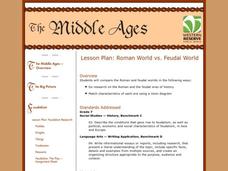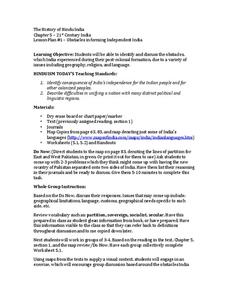National Museum of the American Indian
The Kwakwaka'Wakw: A Study of a North Pacific Coast People and the Potlatch
Discover the cultural practices and unique value systems of a group of native peoples from Canada called the Kwakwaka'wakw. Your young historians will discuss how conceptions of wealth can vary and how these native people utilized...
Curated OER
Identifying Economic Systems
Young historians practice identifying evidence to categorize a particular country's economic system as either a mixed, centrally planned, traditional, or free economic system in this two-part instructional activity.
Gilder Lehrman Institute of American History
Slave Narratives: Frederick Douglass, Harriet Jacobs, and the Columbian Orator
Young historians practice in-depth, quality analysis of primary source texts in this three-lesson unit, which examines excerpts from the slave narratives of Frederick Douglass, Harriet Jacobs, and Caleb Bingham.
Atlanta History Center
Civil Disobedience and the Atlanta Student Movement
What tactics are used in civil disobedience? Learners study the conditions in Alabama that led to the establishment of the Atlanta Student Movement, as well as consider the nature and effectiveness of civil disobedience.
Delaware Law Related Education Center
Comparing Personal and Civil Responsibility in Croatia and The United States
What rights do citizens in a democracy have? Learners compare the rights of citizens in the United States and Croatia, and examine the personal and civil responsibilities that go along with those rights through a great series of...
Northeastern Educational Television of Ohio, Inc.
Roman World vs. Feudal World
Young historians compare the major features of the Roman and feudal worlds, such as religion, social hierarchy, and political tenets, using online resources and group discussion.
Northeastern Educational Television of Ohio, Inc.
Feudalism Research
Working with a partner, young historians research different feudal roles in medieval Europe (i.e. nobles, knights, clergy, tradesmen, and peasants), create a fact sheet about their assigned roles, and present their findings to the class.
Speak Truth to Power
Marina Pisklakova: Domestic Violence
After reading Article 3 of the Universal Declaration of Human Rights and discussing background material about domestic violence, class members create a map showing where in their community survivors of domestic violence can get help and...
Curated OER
King David
Here is a quick instructional activity on King David, the second king of Israel. It discusses his famous contest with the Philistine warrior Goliath and is followed by a few reading comprehension questions.
Curated OER
Ancient Israelites Part 1
Young historians are given a thorough introduction to ancient Middle East geography and the patriarchs of ancient Israel with a PowerPoint presentation and supplemental worksheets. Topics covered include Abraham as the first patriarch,...
City University of New York
Dutch New York
What patterns appear in the treatment of Jewish and Quaker immigrations to New Netherland? Your class members will work together to read and discuss the religious restrictions placed on immigrants to Dutch New York.
San Antonio Independent School District
The Election of 1824
Here is a nice set of worksheets to get you started on teaching your young historians about the "Corrupt Bargain" in the presidential election of 1824, as well as the Tariff of 1828 and the emergence of new political parties.
San Antonio Independent School District
Political, Economic, and Social Table - The Establishment of the 13 Colonies
Here you'll find a simple graphic organizer that learners can use to categorize the political, economic, and social motivations behind the establishment of the thirteen colonies.
San Antonio Independent School District
Ancient Civilizations
Here is a fantastic set of graphic organizers to accompany your study of civilizations such as ancient Egypt, Sumer, Assyria, and Persia.
San Antonio Independent School District
Colonies in the Americas
Compare and contrast the goals, types of government, interactions with Native Americans, and other important features of the Spanish, British, and French colonies in the Americas with this graphic organizer.
San Antonio Independent School District
Age of Exploration
Here is a great graphic organizer to accompany your study of early European explorers and the Age of Exploration. Learners note the specific contributions of such explorers as Bartholomeu Dias and Vasco de Gama, as well as consider the...
Humanities Texas
Primary Source Worksheet: Frederick Douglass, “Expression of Gratitude for Freedom”
Here is a fantastic primary source analysis activity regarding Frederick Douglass' speech delivered at the unveiling of the Freedmen's Monument in 1876. The follow-up discussion questions and activities highlight Douglass' discussion of...
Humanities Texas
Primary Source Worksheet: Excerpt from the Diary of Union Soldier Samuel Cormany
Young historians read and analyze a soldier's direct account of his participation in the battle of Gettysburg, as well as consider the overall strategy and tactics taken by the Union and Confederate troops.
Humanities Texas
Primary Source Worksheet: “Report on Manufacturers,” Annals of Congress
Invite your learners to take a look at life during the term of United States president George Washington through analysis of an interesting primary source. The document summarizes American manufacturing capacities, as detailed by the...
Humanities Texas
Primary Source Worksheet: Letter Regarding the Whiskey Rebellion
Analyze the federal government's direct response to the Whiskey Rebellion through this fantastic primary source analysis activity activity.
Kauai's Hindu Monastery
The History of Hindu India
What obstacles did India face during their post-colonial formation after gaining independence? Topics discussed in the lesson include Pakistan's conflict over Kashmir, the Indian Constitution, economic development, and the influence of...
Smithsonian Institution
Mary Henry: Journal/Diary Writing
A great way to connect social studies with language arts, a resource on Mary Henry's historical diary reinforces the concepts of primary and secondary sources. It comes with an easy-to-understand lesson plan, as well as the reference...
National Endowment for the Humanities
Using Historic Digital Newspapers for National History Day
Your learners will take a trip through history as they peruse through historic digitalized newspapers, reading real articles from such historical periods in the United States as the Temperance movement and passage of the Thirteenth...
Humanities Texas
Primary Source Worksheet: Abraham Lincoln, Second Inaugural Address
Your young historians will be intrigued to read and analyze Abraham Lincoln's second inaugural address, which discusses the president's take on the causes of the Civil War and connections between the North and the South.

























